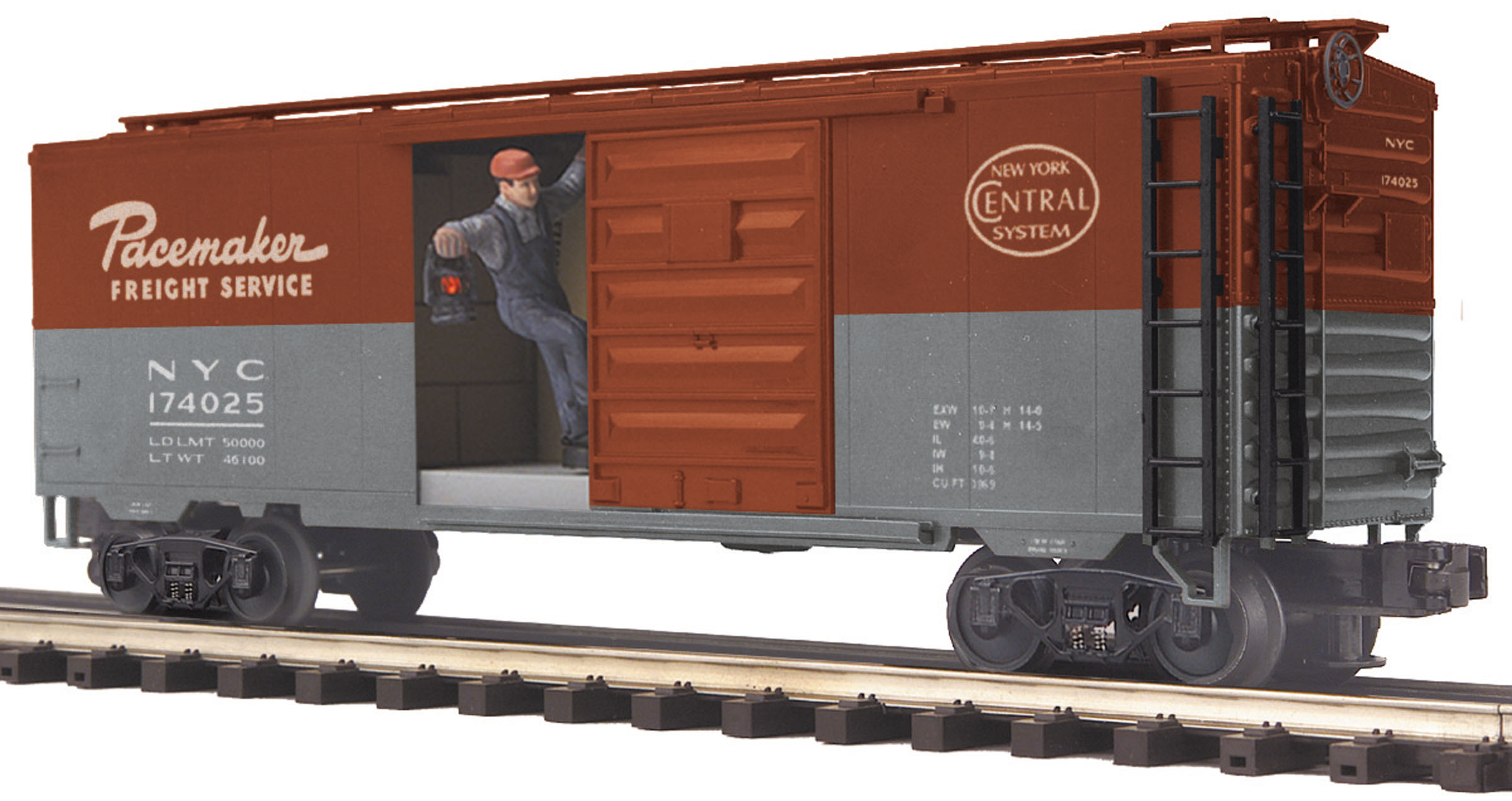One of the brightest images in Post-War freight railroading came from the New York Central in 1946 with the inauguration of Pacemaker Freight Serivce. Trains NB-1 and BN-2 linked New York City and Buffalo as the line haul portion of the NYC's premium less than car load freight service that included door to door delivery of merchandise between the terminal cities and points in between. The trains were made up of 40 foot box cars specially equipped for fast LCL service and painted in vermilion and light gray Pacemaker colors and were powered by the NYC's fast Niagara or Mowhawk locomotives. The service proved to be a success and was expanded with dedicated trains to Boston and Cleveland. Pacemaker boxcars moved in other scheduled freight trains to reach more distant points served by the New York Central System. The Central's promotional photos and films made an impression that has lasted nearly 70 years and Pacemaker freight cars remain popular among O scale operators today.

In this installment of the O Scale Road Name Guide we will take a chronological look at Pacemaker boxcars and the O scale equipment that is available to model them.
Pacemaker service cars came from a group of 1000 standard 40 foot boxcars converted for dedicated LCL service. They received special air brakes and Barber stabilized high speed freight trucks. The cars were painted vermilion and light gray with white lettering. No interior dimension data was stenciled on the car sides since the data was only required on cars in interchange service and Pacemaker cars were not allowed to leave New York Central System rails.
These first Pacemaker boxcars were built to the standard AAR box car design of the day. We have two models of the 1937 AAR box car available in O scale today, one from Atlas and one from MTH. The Atlas Pacemaker boxcars have Murphy rectangular panel roofs like the NYC prototypes. The MTH AAR boxcars feature a Viking roof. Both the MTH and Atlas cars have 4/5 Dreadnought ends which are incorrect. The NYC prototypes were built with the then brand new improved Dreadnought end.
The Atlas 8561 AAR box car features the original 174000 series car number, all white lettering and no dimensional data. It was made in 4 road numbers.

The MTH 20-93291 was also decorated in the original paint scheme. It first appeared in the 2006 Volume I catalog and two numbers were available. The same scheme appeared again in the 2010 Volume II catalog with two more road numbers as the 20-93499.

A total of 24 more individually numbered AAR boxcars were available from MTH in this paint scheme in the 20-90264, 20-90265, 20-909583 and 20-90584 six car sets.
Ten more boxcars are available in the MTH 20-3377-1 and 20-3411-1 sets that each come with a NYC Mohawk locomotive, five boxcars and a Pacemaker caboose.

After the first few years of Pacemaker service, NYC switchmen complained that the white on light gray reporting marks were hard to read. The NYC revised the Pacemaker paint scheme with black lettering on the gray in the late 40s or early 50s.
Atlas models this revised paint scheme with black (car cement) roof and ends on the 8728 boxcar. It was available in 4 numbers.

The Pacemaker paint scheme was further revised in 1955 with a black background to the NYC herald. Atlas offered this paint scheme in two road numbers on the 8569 boxcar.

MTH has offered the late Pacemaker scheme in two numbers on the 20-93629 boxcar in the 2014 Volume II catalog.

MTH is offering twelve more late scheme cars in the 2014 Volume II catalog in the 20-90872 and 20-90873 six car sets.

An additional 200 boxcars entered Pacemaker service on a temporary basis. These cars received Pacemaker lettering but remained in their standard color. Atlas has modeled these cars in two numbers.

The final cars to enter Pacemaker Service were PS-1s, received by the NYC from Pullman-Standard in 1954. They wore vermilion and gray with black reporting marks.
Lionel offered their excellent PS1 boxcar in Pacemaker colors with black reporting marks back in 2002. It was made in only one road number. The dimensional data is appropriate for a Pacemaker box car renumbered to the 175000 series for interchange service.

MTH made an operating version of their PS1 boxcar in Pacemaker colors as the 20-93186. Two numbers are available.

There are also 12 individually numbered MTH PS1s available from the 20-90098 and 20-90099 six car sets.
![]()
Weaver has also made Pacemaker PS1s in at least 4 numbers. Those observed on the bay have correct all red doors.

The NYC had five cabooses repainted for Pacemaker freight service. The only commercially available O scale cabooses that come close to the prototype are the MTH standard NYC wood cabooses included in the Mohawk sets and the diecast Railking 30-8507. But the Pacemaker cabooses were not standard NYC wood cabooses. They were longer, having been rebuilt from 40 foot box cars. While O scale brass models are out there several have been scratch built by the forum's own Bother Love. Contact him if you are interested in acquiring one of your own.
Pacemaker service came to a close in the late 50s as NYC's early bird and Flexi-Van services took its place. Some Pacemaker box cars retained their vermilion and gray colors and simply received standard capacity and dimensional data to allow them to enter interchange service. If you model the NYC from the mid 40s to the mid 50s or any North American railroad from the late 50s through the 1960s there are Pacemaker boxcars for you.
If anyone has corrections or additions please share them.
For those interested in O scale freight car models have a look at the O Scale Freight Car Guide series here.
https://ogrforum.com/t...le-freight-car-guide
A growing collection of information on models available for particular road names is available here.
https://ogrforum.com/t...me-guide-up-cabooses













